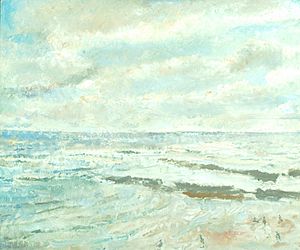Ethel Walker facts for kids
Dame Ethel Walker was a talented Scottish painter. She was known for her portraits, flower paintings, and pictures of the sea. Her art was influenced by styles like Impressionism and Asian art. Ethel Walker had a very successful career. In 1900, she became the first woman to be elected a member of the New English Art Club. Her paintings were shown in many places, including the Royal Academy of Arts. She even represented Britain at the Venice Biennale art show four times! In 1943, she was honored as a Dame Commander of the Order of the British Empire, a very special award. After she passed away, a big exhibition of her work was held at the Tate gallery in 1951.
Contents
Early Life and Art Training
Ethel Walker was born in Edinburgh, Scotland, on June 9, 1861. Her father was from a family that made iron. She went to secondary school in London at Brondesbury, where she learned drawing.
After school, Ethel studied at the Ridley School of Art. In 1880, she met another artist, Clara Christian, and they lived and studied together. Ethel also attended the Putney School of Art and Design. She traveled to Madrid, Spain, where she copied paintings by the famous artist Velázquez.
Later, she studied at the Westminster School of Art in London. There, she learned from a popular artist named Frederick Brown. Around 1893, she followed Brown to the Slade School of Art for more studies. She also took evening painting classes with Walter Sickert. Ethel returned to the Slade School several times to learn different painting styles and even sculpture.
Ethel Walker's Art Career

Ethel Walker created many different kinds of artworks. These included paintings of flowers, seascapes, landscapes, and even mythical scenes. She was inspired by Greek art, Renaissance art, and Chinese painting. She also found inspiration in Taoism, a Chinese philosophy.
Walker was especially known for her portraits of women. She paid close attention to their expressions and personalities. Her brush strokes were clear and bold, helping her to show the mood of the moment. She believed in showing the natural female form. She even asked her models not to wear makeup or nail polish when they posed for her.
Her art often captured the human spirit and celebrated beauty. Ethel Walker's paintings had a positive and thought-provoking impact on the art world. Her works are still shown in galleries today, like The Gatehouse Gallery in Glasgow, Scotland. In 1940, she became an Associate of the Royal Academy of Arts.
Ethel Walker painted many different people. Her subjects included other artists like Nicolette Macnamara and Orovida Camille Pissarro. She also painted important people like the politician Nancy Astor. Walker even painted a study of young Christopher Robin Milne, whose father wrote the Winnie the Pooh books.
Ethel Walker's Personal Life
Ethel Walker was a very social artist. She lived for many years in her studio in Chelsea, London. She was very involved in the art scene there. The famous writer George Moore (novelist) recognized her talent. He introduced her to French Impressionism after she met him in Paris.
Walker had many friends, including the writer William Rothenstein. In 1935, Rothenstein held a dinner in her honor with about seventy guests. Famous artists and writers like Virginia Woolf, Duncan Grant, and Vanessa Bell were there. Virginia Woolf wrote in her diary that she had "great fun" at the party. Walker even painted Vanessa Bell in 1937.
Ethel Walker did not like cosmetics. She was known to tell women in public to remove their makeup. She always asked her models to take off lipstick and nail polish before painting them. One friend remembered that she would say, "Take that filthy stuff off your lips!"
In her later years, Ethel Walker became friends with a Polish artist named Marian Kratochwil. He had come to London after fleeing Europe in 1947. When Walker passed away, Kratochwil discovered that she had secretly left him her estate, including all the paintings in her studio. He and his wife later gave many of these artworks to art galleries.
Exhibitions and Recognition
Ethel Walker showed her art widely during her life and received a lot of praise. She began exhibiting at the Royal Academy of Arts in 1898. Throughout the 1920s, she was one of the most frequently shown women artists in their annual Summer Exhibition.
After her painting Angela was shown in 1899, she became the first female member of the New English Art Club in 1900. A review in 1913 praised her work, saying she "sees delicately and paints delicately." The review called her work "the strongest in the gallery."
From 1930 onwards, Walker had many exhibitions at the Lefevre Gallery. She also showed her art at The Redfern Gallery for many years.
In 1938, Queen Elizabeth The Queen Mother, who loved art, bought Walker's painting At Sea on an October Morning. The Queen's interest in Walker's art was likely influenced by her art mentor, Jasper Ridley, who owned several of Walker's works.
In 1951, the Tate gallery held a big exhibition to remember Ethel Walker, Frances Hodgkins, and Gwen John. Critics praised the show, saying the three artists made a significant contribution to British painting. As of 2008, Ethel Walker is one of the few women artists with many works in the Tate collection.
In 2017, Walker's large painting Decoration: The Excursion of Nausicaa was part of the "Queer British Art" exhibition at Tate Britain.

